#Fashion Education
Text
Femme Fatale Guide: Fall Wardrobe Essentials
Staple Tees:
**Purchase in Modal, Pima cotton, or a cotton-cashmere blend**
Fitted crewneck tees (long-sleeves/tees & tanks for layering)
Relaxed fit long-sleeve tees
Turtleneck long-sleeve top (fitted & relaxed fit options)
Contour bodysuits
Blouses/Shirting:
Silk button-down blouse
Cotton button-down blouse
Silk shell top/t-shirts/camis (for layering)
Sculpt knit top(s)
Self-tie wrap blouse
Shirred boatneck, mock neck, or cowlneck silk blouse(s)
Leather button-down
Knitwear:
Thin cashmere/wool crewneck sweater (fitted/relaxed fit)
Thin cashmere/wool turtleneck sweater
Chunky relaxed-fit cable knit sweater
Knit polo-neck sweater
Cashmere sweater vest (crewneck, v-neck, and/or turtleneck)
Mockneck cashmere/wool sweater
Cashmere long-sleeve sweater dress
Cashmere/knit skirt (mini, midi, or maxi - depending on your personal preferences)
Sophisticated coordinating knit set (top/pants or skirt of your choice)
Casual knit set (top/pullover and relaxed fit pants)
Cashmere cardigan
Cable knit cardigan (doubles as a light jacket)
Bottoms:
Black straight-leg jeans
Black bootcut/flared jeans
Black straight/bootcut trousers
Wide-leg trousers (I love a solid black, black pinstripe, and black with lace-up detail selection)
High-waisted leather pants
Split hem trousers
Stretch jersey/cashmere pants (straight-leg or flared)
Quilted leather/tweed mini skirt
Knit/wool mini and/pencil skirt
Leather skirt (mini or midi)
Silk midi skirt
Dresses/Jumpsuits:
Knit/sweater dress
Little black dress (shift dress/A-line cuts are great)
Blazer dress/jumpsuit
Slip dress (for layering)
Minimal black jumpsuit ("LBJ")
Leather and/or denim dress or jumpsuit
Jackets & Outerwear:
Black tailored blazer
Leather blazer
Tweed jacket
Trench coat
Leather moto/cropped/bomber jacket
Black wool coat
Raincoat ( I like Rains for high-quality options on the affordable side that are still built to last for several seasons)
Statement jacket/coat
Footwear:
Sleek flat/low-heel black boots with a pointed-toe or square-toe silhouette (I love Vagabond, Jeffrey Campbell, Vince Camuto, and Sam Edelman for more affordable, high-quality options)
Black loafers/sleek black flats
Black lace-up boots
Black heeled boots
Black pumps
White sneakers
Rain boots (I recommend the Melissa Shoes Welly/Grip/Step boots or a stylish, sustainable, and more affordable option)
Accessories:
White/black ankle & crew socks
Black control top tights
High-waisted shapewear shorts
Chunky/small chain necklaces & bracelets
Simple pendant necklace(s)
Pearl necklace
Simple diamond studs
Crystal drop earrings
Minimalist bangles
Stackable rings
A sleek, minimalist black tote (can fit a laptop for work/travel)
Black shoulder bag
Small black bag (top handle, crossbody, etc.)
Statement bag/evening bag
Cashmere scarf
Silk/decorative scarf
Fingerless/touch-screen friendly, lightweight gloves
Lingerie/Loungewear:
Seamless bra/underwear
Lace bra/underwear
Matching pullover cotton sweatshirt/sweatpants
Knit or jersey cotton top/lounge pants set
Luxurious pajama set (silk, Tencel, cashmere, etc.)
A to-die-for piece of lingerie like a lace slip/silk teddy
Silk or cozy robe
Cozy open-back slippers
#fashion advice#capsule wardrobe#wardrobe staples#custom wardrobe#personal style#personal branding#wardrobe design#style advice#style tips#fashion trends#outfit inspiration#styling tips#fashion education#fashion editorial#outfit ideas#black outfit#fall outfits#fall wardrobe#femme fatale#it girl#self concept#glow up tips#femme fetale aesthetic#femmefatalevibe
549 notes
·
View notes
Text
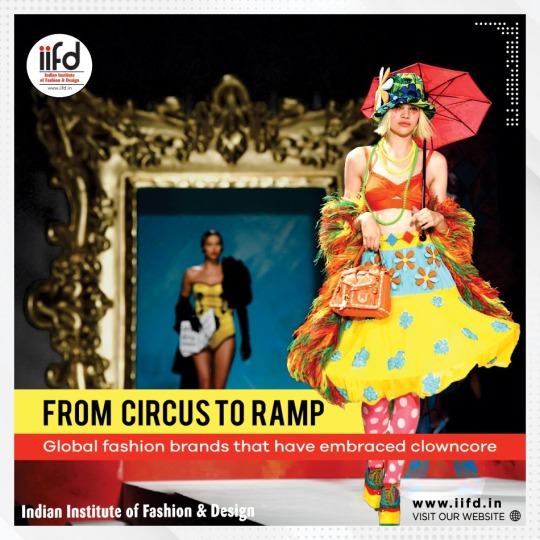


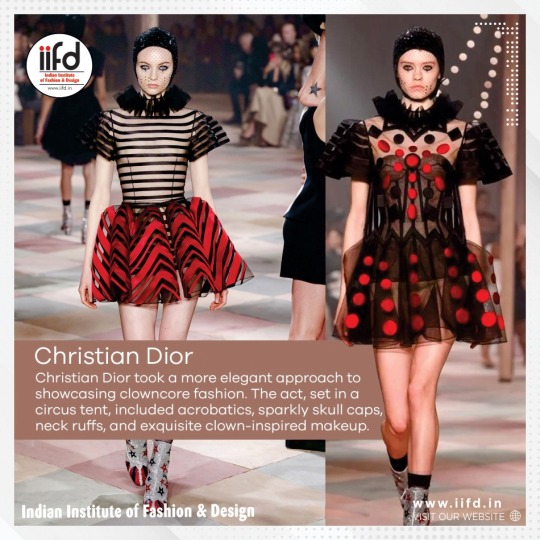
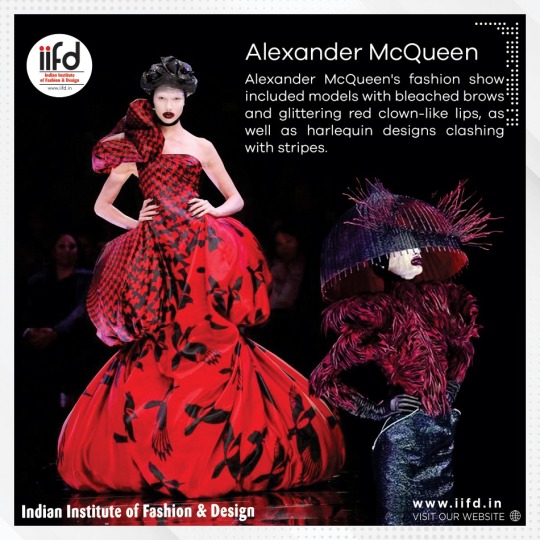
Check out these awesome brands that turned clown fashion into a big hit! From colorful outfits to fancy runways, Dior, Moschino, Alexander McQueen, and Vivienne Westwood are making clowncore cool!
2 notes
·
View notes
Text
Reading Princess Jellyfish when you're studying or have studied fashion in school is so satisfying. I wanna hug the author (Akiko Higashimura) and thank her for all the research she's put into the fashion industry for this amazing series!
5 notes
·
View notes
Text
Clothing 101: A Comprehensive Guide to Understanding and Navigating the World of Fashion

Title: Clothing 101: A Comprehensive Guide to Understanding and Navigating the World of Fashion
Introduction: Clothing is an essential aspect of our daily lives. It not only serves as a basic necessity for protection and comfort but also plays a significant role in self-expression, cultural identity, and personal style. The world of fashion can be vast and complex, with ever-changing trends, styles, and industry dynamics. To help you navigate this fascinating and dynamic world, this article serves as a comprehensive guide to Clothing 101, providing you with essential knowledge about clothing and fashion.
Chapter 1: Understanding Clothing Basics This chapter delves into the fundamental concepts of clothing, including its purpose, functions, and history. It covers topics such as the evolution of clothing from early civilizations to modern times, the various types of clothing (e.g., outerwear, underwear, formalwear, casual wear), and the significance of clothing in different cultures and societies. It also includes information on the different types of fabrics, fibers, and textiles used in clothing, as well as an overview of the clothing manufacturing process.
Chapter 2: Building a Wardrobe In this chapter, we explore the art of building a functional and stylish wardrobe. It covers topics such as understanding body types and how to dress for your body shape, determining your personal style and fashion preferences, and creating a wardrobe that reflects your lifestyle, needs, and budget. It also includes tips on how to organize and care for your clothing, as well as strategies for building a sustainable and eco-friendly wardrobe.
Chapter 3: Understanding Fashion Trends Fashion trends are constantly evolving, and understanding them is essential for anyone interested in clothing and fashion. This chapter covers topics such as the concept of fashion cycles, the role of fashion influencers and designers in shaping trends, and the impact of cultural, social, and economic factors on fashion. It also provides tips on how to stay updated with current fashion trends and how to interpret and adapt them to suit your personal style.
Chapter 4: Dressing for Occasions Different occasions call for different dress codes, and this chapter provides an overview of how to dress appropriately for various occasions. It covers topics such as formal wear for business and social events, casual wear for everyday activities, and special occasions such as weddings, parties, and holidays. It also includes information on cultural and regional dress codes, as well as tips on how to dress for different climates and weather conditions.
Chapter 5: Styling and Accessorizing Styling and accessorizing are crucial elements of fashion, and this chapter provides insights on how to elevate your outfits with the right styling techniques and accessories. It covers topics such as understanding color theory, mixing and matching patterns and textures, and creating balanced and cohesive looks. It also includes information on different types of accessories such as jewelry, bags, shoes, and hats, and how to use them to enhance your overall look.
Chapter 6: Fashion and Identity Fashion is closely tied to identity, and this chapter explores the relationship between clothing and self-expression. It covers topics such as how clothing can be used to communicate personal values, beliefs, and interests, and how it can reflect cultural, social, and gender identities. It also includes discussions on body positivity, inclusivity, and diversity in fashion, as well as the impact of fashion on self-esteem and confidence.
Chapter 7: Fashion and Sustainability Sustainability is a growing concern in the fashion industry, and this chapter sheds light on the environmental and social impacts of clothing production and consumption. It covers topics such as the concept of fast fashion, the importance of ethical and sustainable fashion practices, and the role of consumers in making responsible fashion choices. It also includes tips on how to shop consciously, care for clothing to extend its lifespan, and support sustainable fashion brands.
Conclusion
#Fashion Basics#Wardrobe Essentials#Clothing Tips#Fashion Trends#Styling Techniques#Dressing for Occasions#Personal Style#Fashion Identity#Sustainable Fashion#Clothing Care#Body Positivity#Fashion History#Fashion Industry#Fashion Education#Fashion Choices
2 notes
·
View notes
Text
He Knows What You'll Wear Next Summer: Inside the Unique Fashion World of Jurgi Persoons
Jurgi Persoons is not a household fashion name but this is only a sign of the times. In a parallel, ideal universe the Belgian designer and educator would have gotten the place he deserves, this of the original voice of the 90s avant-garde scene, probably the last authentic trend the fashion storyline has seen so far. His short run as a designer produced some of the most sought-after items…
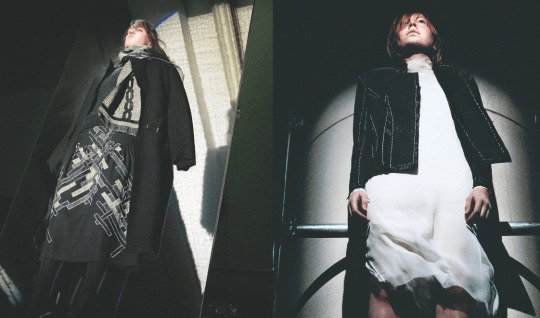
View On WordPress
4 notes
·
View notes
Text
Fashion Designing Essentials: Education for Aspiring Designers
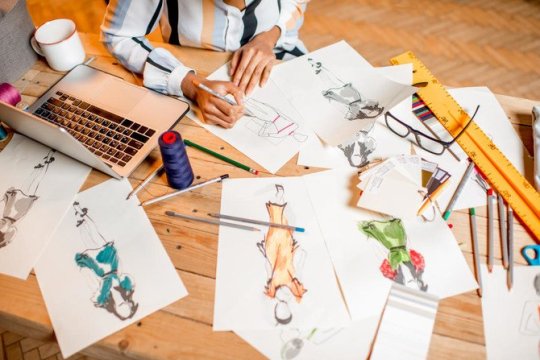
Fashion design is a dynamic and multifaceted field that requires a combination of creativity, skill, and industry knowledge. For aspiring designers, acquiring the essential education is crucial to navigating the complexities of the fashion industry and building a successful career. In this blog, we'll delve into the fundamental aspects of fashion designing education and explore how the Indian Institute of Fashion and Design (IIFD) provides aspiring designers with the essential tools and knowledge needed to thrive in this competitive industry.
Understanding Design Principles:
At the core of fashion design education are the fundamental design principles that form the basis of creative expression. Students at IIFD learn about color theory, composition, silhouette, proportion, and texture, gaining a deep understanding of how these elements come together to create visually compelling designs. Through practical exercises and hands-on projects, aspiring designers hone their skills in applying these principles to their own creations.
Developing Technical Skills:
In addition to creativity, aspiring designers must possess a strong foundation in technical skills to bring their designs to life. At IIFD, students receive comprehensive training in pattern-making, draping, sewing, and garment construction. From sketching their initial concepts to producing fully realized garments, students gain the practical expertise needed to translate their ideas into wearable fashion.
Exploring Fashion History and Trends:
A thorough understanding of fashion history and trends is essential for aspiring designers to contextualize their work and stay informed about industry developments. Through courses in fashion history and trend forecasting, students at IIFD gain insights into the evolution of fashion over time and learn how to identify emerging trends and influences. This knowledge equips them with the foresight to create designs that are both innovative and relevant to contemporary audiences.
Learning Business and Marketing Skills:
While creativity is a cornerstone of fashion design, aspiring designers must also possess a solid understanding of business and marketing principles to succeed in the industry. At IIFD, students learn about branding, merchandising, retailing, and entrepreneurship, gaining the skills needed to navigate the business side of fashion. By understanding the market landscape and consumer behavior, aspiring designers can effectively position their brands and products for success.
Join one of the Best Fashion Design Colleges in Kolkata like IIFD - Indian Institute of Fashion and Design in Salt lake Kolkata (@iifdkolkata) and embark on a transformative journey towards realizing your creative aspirations. Our comprehensive programs provide aspiring designers with the essential education, skills, and industry knowledge needed to thrive in the competitive world of fashion. Visit our website to learn more about our courses, admissions process, and how you can start your journey towards a successful career in fashion design at IIFD.
Conclusion:
Fashion designing education is essential for aspiring designers to develop the skills, knowledge, and expertise needed to succeed in the fast-paced and competitive fashion industry. At the Indian Institute of Fashion and Design (IIFD), we are committed to providing aspiring designers with the essential tools and education needed to unlock their creative potential and build successful careers in fashion design. With our comprehensive programs and industry-focused curriculum, we empower aspiring designers to turn their passion for fashion into reality.
#Fashion Education#Fashion Design#Fashion Designing#IIFD#IIFD Kolkata#careers#education#fashion design college#fashion design institute#fashion design course#fashion design education
0 notes
Text
Fashion Designing Reimagined: Pushing Boundaries, Defining Trends

In the world of fashion, innovation is the key to staying ahead of the curve. As trends evolve and consumer preferences shift, designers must constantly push boundaries and reimagine the possibilities of fashion. At the Indian Institute of Fashion and Design (IIFD) in Kolkata, we believe in fostering creativity and empowering our students to redefine the landscape of fashion. In this article, we'll explore how fashion designing is being reimagined at IIFD Kolkata, and how our approach is shaping the future of the industry.
Embracing Creativity and Innovation:
At IIFD Kolkata, we encourage our students to think outside the box and embrace creativity in all its forms. Our faculty members are industry professionals with a passion for innovation, and they inspire students to push the boundaries of traditional fashion design. From experimental techniques to unconventional materials, we encourage our students to explore new avenues and challenge the status quo, leading to groundbreaking designs that captivate and inspire.
Defining Trends, Not Following Them:
While it's important to stay informed about the latest trends, true innovation comes from setting trends rather than following them. At IIFD Kolkata, we empower our students to define their own unique aesthetic and create designs that reflect their individuality and vision. By encouraging personal expression and creative exploration, we foster a culture of innovation that leads to designs that are fresh, relevant, and ahead of the curve.
Collaboration and Cross-Pollination:
Innovation thrives in an environment of collaboration and cross-pollination of ideas. At IIFD Kolkata, we facilitate interdisciplinary collaboration between students from different backgrounds and disciplines. Whether it's partnering with textile designers, graphic artists, or technologists, we encourage our students to collaborate across disciplines to create truly unique and groundbreaking designs that push the boundaries of fashion.
Adopting Sustainable Practices:
In addition to pushing boundaries and defining trends, fashion designing at IIFD Kolkata is also about embracing sustainability. We believe that fashion should not only be beautiful and innovative but also ethical and environmentally conscious. Our curriculum includes courses on sustainable fashion practices, and we encourage our students to explore eco-friendly materials, production techniques, and design strategies that minimize the industry's environmental footprint.
Ready to reimagine the future of fashion? Join us at the Indian Institute of Fashion and Design - IIFD Kolkata and become part of a community that is pushing boundaries, defining trends, and shaping the future of the industry. Our innovative programs, experienced faculty, and industry-focused curriculum provide aspiring designers with the education, training, and resources they need to succeed in the dynamic world of fashion. Visit our website to learn more about our courses, admissions process, and how you can start your journey towards a successful career in fashion designing at one of the Best Fashion Design Colleges in Kolkata, IIFD - Indian Institute of Fashion & Design, in Salt lake Kolkata (@iifdkolkata).
Conclusion:
Fashion designing is undergoing a renaissance, with designers around the world pushing boundaries, challenging conventions, and redefining the possibilities of fashion. At IIFD Kolkata, we are at the forefront of this movement, empowering our students to unleash their creativity, define trends, and shape the future of the industry. Through a culture of innovation, collaboration, and sustainability, we are reimagining fashion designing as a force for positive change, and we invite you to join us on this exciting journey towards a more vibrant, inclusive, and sustainable future of fashion.
#Reimagined#Fashion Designing#Fashion Design#iifd#iifdkolkata#IIFD Kolkata#careers#education#fashion#fashion education#educate yourself#Fashion Design Courses
0 notes
Text
What is the Future of Fashion Business?

The fashion industry is constantly evolving, driven by shifting consumer preferences, technological advancements, sustainability concerns, and global trends. As we look ahead, it's essential for fashion businesses to anticipate and adapt to emerging changes to stay relevant and competitive in the market. In this article, we'll delve into the future of fashion business, exploring key trends, challenges, and opportunities that lie ahead, with insights from IIFD Kolkata.
Sustainability and Ethical Practices:
One of the most significant trends shaping the future of fashion business is the growing emphasis on sustainability and ethical practices. Consumers are increasingly demanding transparency, accountability, and sustainability in the fashion industry, prompting brands to rethink their supply chains, production processes, and material sourcing. Fashion businesses that prioritize sustainability and embrace ethical practices will have a competitive advantage in the future market landscape.
Digital Transformation:
The digital revolution is transforming every aspect of the fashion business, from design and production to marketing and retail. E-commerce, social media, and digital marketing have revolutionized how fashion brands connect with consumers, enabling personalized shopping experiences and direct-to-consumer sales channels. Additionally, technologies such as artificial intelligence, augmented reality, and 3D printing are reshaping the design process and supply chain management. Fashion businesses that embrace digital transformation and leverage technology to enhance efficiency, innovation, and customer engagement will thrive in the future.
Personalization and Customization:
In the future of fashion business, personalization and customization will play a central role in meeting the diverse needs and preferences of consumers. With advancements in technology and data analytics, fashion brands can offer personalized products, services, and shopping experiences tailored to individual tastes, sizes, and style preferences. Mass customization, made-to-order production, and on-demand manufacturing will become increasingly prevalent, allowing brands to cater to niche markets and reduce overproduction.
Circular Economy and Waste Reduction:
As the fashion industry grapples with environmental challenges such as waste pollution and resource depletion, the future of fashion business will see a shift towards a circular economy model. Fashion brands are exploring innovative solutions to minimize waste, extend the lifespan of garments, and promote circularity through practices such as recycling, upcycling, and garment rental. Adopting circular business models will not only reduce environmental impact but also drive cost savings and foster consumer loyalty.
Diversity, Inclusivity, and Representation:
The future of fashion business will be characterized by greater diversity, inclusivity, and representation across all aspects of the industry. Consumers are demanding greater diversity in product offerings, marketing campaigns, and brand messaging, reflecting the diverse demographics of today's society. Fashion businesses that embrace diversity, champion inclusivity, and prioritize representation in their leadership, workforce, and marketing efforts will resonate with consumers and foster a more inclusive industry.
Conclusion:
The future of fashion business holds immense potential for innovation, sustainability, and growth. By embracing trends such as sustainability, digital transformation, personalization, circularity, and diversity, fashion businesses can position themselves for success in an ever-evolving market landscape. At IIFD - Indian Institute of Fashion & Design in Kolkata (@iifdkolkata), we are committed to preparing future fashion industry leaders to navigate the challenges and opportunities of tomorrow, equipping them with the skills, knowledge, and insights to drive positive change and shape the future of fashion business. Join the best Fashion Designing College in Kolkata like IIFD Salt lake Kolkata and embark on a transformative journey to lead the fashion industry into a sustainable, inclusive, and innovative future.
#Future of Fashion Business#Fashion Business#Business#Future#Fashion Design#Fashion Designing#IIFD#IIFD Kolkata#Education#careers#fashion education
0 notes
Text
Digital Tools in Fashion Design
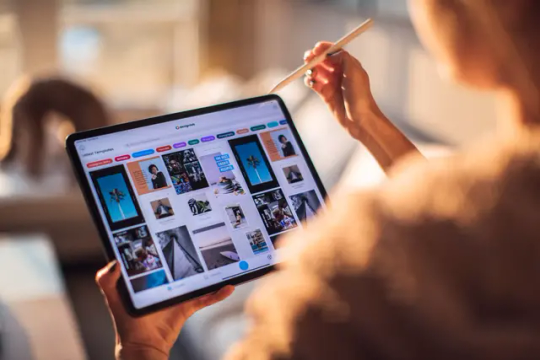
In the digital age, technology has revolutionized every aspect of the fashion industry, including the design process. Digital tools have become indispensable for fashion designers, offering innovative solutions for sketching, pattern-making, prototyping, and more. In this blog post, we'll explore the transformative impact of digital tools in fashion design and how IIFD equips students with the skills and knowledge to leverage these tools effectively.
Sketching and Illustration Software:
Digital sketching and illustration software have streamlined the design process, allowing designers to create detailed sketches and renderings with precision and ease. Programs like Adobe Illustrator and Adobe Photoshop offer powerful tools for creating digital sketches, exploring color palettes, and experimenting with design variations. At IIFD, students learn how to use these software applications to bring their design concepts to life digitally, refining their ideas and communicating their vision effectively.
3D Modeling and Virtual Prototyping:
Advancements in 3D modeling software have revolutionized the way fashion designers conceptualize and develop their designs. With 3D modeling tools like CLO, Marvelous Designer, and Browzwear, designers can create virtual prototypes of garments, visualize how fabrics drape and move, and simulate the entire design process digitally. This allows designers to iterate quickly, experiment with different design elements, and minimize material waste. At IIFD, students receive training in 3D modeling software, enabling them to create realistic virtual prototypes and bring their designs to life in a digital environment.
Pattern-making and CAD Software:
Traditional pattern-making techniques have been supplemented by Computer-Aided Design (CAD) software, which allows designers to create and modify patterns digitally. CAD software like Optitex, Lectra, and Gerber enables designers to draft, grade, and manipulate patterns with precision, saving time and reducing errors. At IIFD, students learn how to use CAD software to develop custom patterns, optimize garment fit, and streamline the production process, preparing them for careers in the fashion industry.
Digital Textile Design:
Digital textile design has transformed the way designers create and manipulate patterns, prints, and textures for fabrics. Designers can use software like Adobe Photoshop and Adobe Illustrator to create intricate textile designs, experiment with color combinations, and visualize how patterns will appear on garments. Additionally, advancements in digital printing technology have made it possible to produce high-quality, customizable fabrics on-demand. At IIFD, students explore digital textile design techniques, learning how to create original prints and patterns that reflect their unique design aesthetic.
Collaboration and Communication Tools:
In addition to design software, digital tools facilitate collaboration and communication among fashion design teams, suppliers, and manufacturers. Project management platforms like Trello and Asana help teams coordinate tasks, track progress, and manage deadlines effectively. Additionally, communication tools like Slack and Zoom enable designers to collaborate remotely, share feedback in real-time, and stay connected with colleagues across the globe. At IIFD Kolkata, students gain experience using these collaboration tools, preparing them for the collaborative nature of the fashion industry.
Conclusion:
Digital tools have revolutionized the fashion design process, offering designers unprecedented opportunities for creativity, efficiency, and collaboration. At IIFD, we recognize the importance of equipping students with the skills and knowledge to leverage these tools effectively. Through hands-on training, industry-relevant curriculum, and state-of-the-art facilities, we empower students to embrace innovation, explore new possibilities, and thrive in the dynamic world of fashion design. Join the best Fashion Designing College in Kolkata like IIFD Salt lake Kolkata and unlock your potential to shape the future of fashion with digital tools.
#IIFD Kolkata#IIFD#Fashion Design#Fashion Design Education#Fashion Education#Fashion Designing#education#careers#fashion design courses#fashion designing courses#fashion design college#fashion desingers
0 notes
Text
Learn Fashion Design and Unlock Your Creative Potential

Fashion design is not just about creating clothes; it's about channeling your creativity, expressing your unique vision, and making a statement in the world of style. Whether you're dreaming of designing couture gowns, launching your own fashion label, or making your mark as a trendsetting fashion illustrator, the journey starts with education. In this blog post, we'll explore how learning fashion design can help you unlock your creative potential and pave the way for a fulfilling career in the dynamic world of fashion, with the support of IIFD by your side.
Discover Your Passion:
Embarking on a journey in fashion design begins with discovering your passion. Are you drawn to sketching and creating striking silhouettes? Do you have a keen eye for color, texture, and detail? Are you fascinated by the process of bringing ideas to life through fabric and form? By enrolling in a fashion design program at IIFD, you'll have the opportunity to explore a variety of techniques, disciplines, and specialties, allowing you to discover where your true passion lies.
Nurture Your Talent:
While creativity is innate, it also thrives with nurturing and guidance. At IIFD, our experienced faculty members are dedicated to helping you hone your skills, refine your technique, and push the boundaries of your creativity. Through hands-on projects, workshops, and mentorship, you'll have the opportunity to experiment with different mediums, collaborate with peers, and develop a strong foundation in design principles, from sketching and patternmaking to draping and garment construction.
Gain Industry Insights:
In addition to technical skills, success in the fashion industry requires a deep understanding of the business side of fashion. At IIFD, we provide comprehensive education that goes beyond the studio, offering insights into fashion history, trend forecasting, merchandising, branding, and marketing. By gaining a holistic understanding of the industry, you'll be better equipped to navigate the competitive landscape and position yourself for success in your career.
Forge Connections:
Networking is essential in the world of fashion, and at IIFD, you'll have the opportunity to connect with industry professionals, alumni, and fellow students who share your passion for design. Through guest lectures, industry events, internships, and collaborations, you'll build valuable relationships and gain exposure to real-world opportunities that can propel your career forward.
Embrace Innovation:
Fashion is an ever-evolving art form, and success in the industry requires a willingness to embrace innovation, adapt to change, and push the boundaries of creativity. At IIFD Kolkata, we encourage experimentation, risk-taking, and thinking outside the box, empowering you to develop your own unique voice and make a bold statement in the world of fashion.
Conclusion:
Whether you dream of seeing your designs on the runway, in the pages of a fashion magazine, or on the racks of your own boutique, the journey starts with education. By learning fashion design at IIFD - the Best Fashion Designing College in Kolkata, you'll have the opportunity to unlock your creative potential, gain industry insights, forge connections, and set yourself on the path to a successful and fulfilling career in fashion. Join us and embark on your journey to becoming a visionary fashion designer today.
#Creative Potential#iifd#iifd kolkata#Fashion Designing#Fashion Design#Fashion education#fashion designing education#careers#education
0 notes
Text
Femme Fatale Guide: Spring Wardrobe Essentials
Staple Tees & Tanks:
**Purchase in Modal, Pima cotton, linen, silk, or Tencel fabric**
Fitted scoop neck tank
Fitted high-neck tank top
Structured, relaxed fit crewneck tee
Fitted scoop neck/crewneck tee
Halterneck tee/mockneck tee
Contour tank/tee bodysuits
Blouses/Shirting:
Linen button-down (can be long/short-sleeve or a tank variety)
Silk button-down (can be a long/short-sleeve or a tank variety)
Relaxed fit silky tank
Relaxed fit silky cami top
Sweetheart neck tube top
Any other desired silk shell top/t-shirts/camis (for layering)
Sculpt knit top(s)
Self-tie wrap blouse
Halter-style silk blouse
Bottoms:
Black straight-leg jeans
Black bootcut/flared jeans
Black straight/bootcut trousers
Wide-leg trousers (I love a solid black, black pinstripe, and black with lace-up detail selection)
Split hem trousers
Black linen trousers
Stretch jersey pants (straight-leg, bootcut, and/or flared)
Black satin midi skirt
Leather skirt (mini or midi)
Tailored shorts (Tencel ones are great for various climates/weather that drastically in temperature/humidity throughout the day)
Leather shorts
Tailored black linen shorts
Dresses/Jumpsuits:
Slip dress (midi-length for every day; mini for hotter days/nights out)
Linen button-down dress (for work/modest dressing)
Linen tank dress (for layering/hotter days)
Little black dress (shift dress/A-line cuts are great)
Minimal black jumpsuit ("LBJ")
Black linen or silk jumpsuit
Blazer dress/jumpsuit
Long-sleeve playsuit/romper
Tuxedo jumpsuit/playsuit
Jackets/Outerwear:
Well-tailored black blazer
Well-tailored black vest
Leather moto jacket
Black trench coat
Tailored longline sleeveless blazer/vest
Neutral-toned racer jacket
Structured utility jacket
Satin coat/trench/blazer (great over transitional nighttime looks)
Footwear:
Black loafers
Square-toe/pointed-toe flats
Slingback/mary-jane flats/casual kitten heels
Short black lace-up boots
Sleek low to mid-calf black square/pointed-toe boot
Western-inspired boot
Minimalist white sneakers
Black pointed-toe pumps
Sleek mules/cut-out flats
Slingblack pointed-toe wedges
Rain boots
Accessories:
White/black ankle & crew socks
High-waisted shapewear shorts
Chunky/small chain necklaces & bracelets
Simple pendant necklace(s)
Pearl necklace
Simple diamond studs
Crystal drop earrings
Minimalist bangles
Stackable rings
A sleek, minimalist black tote (can fit a laptop for work/travel)
Black shoulder bag
Small black bag (top handle, crossbody, etc.)
Statement bag/evening bag
Silk/decorative scarf
Sleek neutral sunglasses that suit your face shape
Lingerie/Loungewear:
Seamless bra/underwear
Lace bra/underwear
Matching pullover cotton sweatshirt/sweatpants
Tencel, Modal, or cotton top/lounge pants set
Luxurious pajama set (Long sleeve/pants + short-sleeve/tank + shorts, depending on the climate – silk, Tencel, cashmere, etc.)
A to-die-for piece of lingerie like a lace slip/silk teddy
Silk or cozy robe
Open-back slippers
#fashion advice#capsule wardrobe#wardrobe staples#custom wardrobe#personal style#personal branding#wardrobe design#style advice#style tips#fashion trends#outfit inspiration#styling tips#fashion education#fashion editorial#outfit ideas#black outfit#femme fatale#it girl#self concept#glow up tips#femme fetale aesthetic#femmefatalevibe#spring outfit#spring clothes#spring style
377 notes
·
View notes
Text
Get a Head Start in Fashion Design Education

Embarking on a career in fashion design is an exciting and rewarding journey. However, in an industry known for its dynamism and creativity, it's crucial to get a head start in fashion design education to stay ahead of the curve. Whether you're a budding designer or someone looking to switch careers, a solid foundation in fashion education can be the key to unlocking your creative potential and building a successful career.
Early Exploration and Passion Discovery:
The journey begins with early exploration and the discovery of your passion for fashion. Many successful designers started sketching, experimenting with fabrics, and developing an eye for style from a young age. If you find yourself constantly drawn to fashion magazines, sketching outfits, or experimenting with your wardrobe, it might be a sign that a career in fashion design is your true calling.
High School Preparations:
High school is the perfect time to start preparing for a future in fashion design. Focus on art and design courses to build a solid foundation. Participate in extracurricular activities such as fashion clubs or sewing classes to gain hands-on experience. Attend fashion-related events and keep a portfolio of your sketches and designs, showcasing your evolving style and creativity.
Research and Choose the Right Fashion School:
As you approach the end of high school, delve into researching and selecting the right fashion school for your education. Look for institutions that align with your career goals, offering comprehensive programs, experienced faculty, and opportunities for industry exposure. Consider factors such as location, reputation, and alumni success stories when making your decision.
Apply for Fashion Design Programs:
Once you've identified your dream fashion school, it's time to apply for their fashion design programs. Pay close attention to application requirements and deadlines. Submit a portfolio that reflects your creativity, passion, and growth as a designer. A strong portfolio can be a game-changer in securing admission to a reputable fashion school.
Immerse Yourself in the Fashion Community:
While pursuing your education, immerse yourself in the fashion community. Attend fashion events, network with industry professionals, and seek internships or part-time positions in the field. Building connections and gaining real-world experience will complement your academic learning and provide valuable insights into the industry.
Ready to take the first step towards a successful career in fashion design? Begin your journey by exploring our Fashion Design Programs. Enroll at the best fashion designing college in India, IIFD - Indian Institute of Fashion & Design, and take the first step towards turning your passion into a thriving career.
Discover our comprehensive fashion courses, distinguished faculty, and state-of-the-art facilities that will shape your creative future. Join IIFD to cultivate your creativity, refine your skills, and set the foundation for a thriving career in the dynamic world of fashion.
Enroll now to get a Head Start in Fashion Design Education!
#fashion#fashion design education#fashion education#fashion designing college#iifd#iifd chandigarh#careers#fashion design#fashion designing courses#education#designing
0 notes
Text
The Role of a Fashion Merchandiser
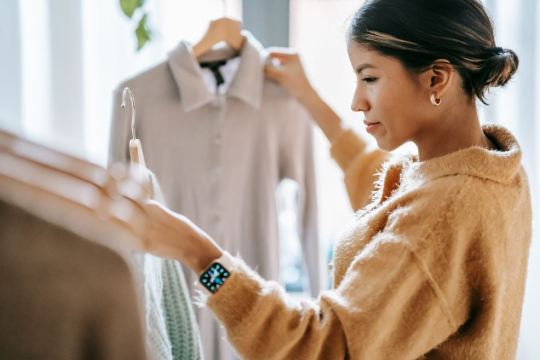
Fashion is an ever-evolving industry where style, trends, and consumer preferences fluctuate at a rapid pace. To navigate this dynamic landscape and ensure that the right garments reach the right consumers, the role of a fashion merchandiser is essential. Fashion merchandisers are the behind-the-scenes experts who bridge the gap between design and retail, shaping the industry in ways that go far beyond just clothing.
Let's explore the multifaceted role of a fashion merchandiser and their impact on the world of fashion.
Defining Fashion Merchandising
Fashion merchandising is a critical component of the fashion industry that involves the planning, purchasing, and selling of garments and accessories. It encompasses various elements, including market research, trend analysis, inventory management, pricing strategies, and visual merchandising. Fashion merchandisers are responsible for ensuring that products are available to consumers when and where they want them.
Market Research and Trend Analysis
One of the primary responsibilities of a fashion merchandiser is to stay ahead of market trends. They monitor consumer preferences, cultural shifts, and emerging fashion trends. By conducting market research and trend analysis, merchandisers can guide their teams in making informed decisions about what products to offer.
Buying and Inventory Management
Fashion merchandisers are responsible for selecting the products that will be available in stores. This involves working closely with designers, manufacturers, and suppliers to determine which items to purchase. They must consider factors such as consumer demand, pricing, and the retail environment. Once products are selected, they manage inventory to ensure that the right quantities are available.
Pricing Strategies
Pricing is a crucial element in the fashion industry. Fashion merchandisers determine the pricing strategies for products based on market demand, production costs, and the competitive landscape. They must strike a balance between profitability and affordability to attract and retain customers.
Visual Merchandising
Fashion is not just about the products; it's also about the presentation. Fashion merchandisers are responsible for creating appealing visual displays in stores and online. They use their creative skills to design eye-catching store layouts, window displays, and online storefronts that entice shoppers and reflect the brand's image.
Assortment Planning
Assortment planning involves deciding which products will be included in a collection and how they will be organized. Fashion merchandisers must ensure that the assortment meets customer expectations and aligns with the brand's identity. They consider factors such as style, color, size, and price to create a well-rounded product offering.
Sales Analysis and Forecasting
Fashion merchandisers continuously analyze sales data to track product performance and customer behavior. They use this data to make adjustments to future buying and inventory management. This ongoing analysis helps ensure that products remain in line with market demand.
Marketing and Promotion
Fashion merchandisers work closely with marketing teams to develop promotional strategies and campaigns. They understand the products they are selling and use their knowledge to create effective marketing materials and sales initiatives.
Seasonal Planning
In the fashion industry, seasonal planning is essential. Fashion merchandisers must plan well in advance to ensure that products are available for specific seasons or occasions. This planning involves identifying which products will be in demand and coordinating with suppliers to meet deadlines.
The Impact of Fashion Merchandisers
The role of a fashion merchandiser is dynamic and multifaceted, with a significant impact on the fashion industry. By understanding market trends, making informed buying decisions, managing inventory, and creating enticing shopping experiences, they contribute to the success of fashion brands and the satisfaction of consumers.
Fashion merchandisers act as the liaisons between designers, manufacturers, retailers, and consumers, ensuring that products reach the right audience at the right time. They play a pivotal role in shaping the style and strategy of fashion brands, ultimately influencing the ever-evolving world of fashion. As fashion continues to evolve, the role of a fashion merchandiser remains an indispensable force in the industry, balancing creativity and commerce in pursuit of style and success.
You can begin your journey towards your dream career in fashion design today by taking the first step. Take advantage of the opportunity to study at one of the top fashion designing colleges in India, IIFD - Indian Institute of Fashion & Design (@iifd) and unlock your potential.
#fashion designing#fashion design careers#iifd#iifd chandigarh#fashion courses#fashion education#fashion design education#career in fashion#career in fashion design#fashion merchandiser#fashion merchandiser career#fashion design institute#careers#education
0 notes
Text
Top Fashion Designing Colleges in Punjab: Your Ultimate Guide
Are you aspiring to make a mark in the glamorous world of fashion? In this guide, we will explore Punjab's top fashion designing colleges, focusing on the Amritsar Group of Colleges. Whether you are a creative soul eager to unleash your artistic potential or a fashion enthusiast with an eye for style, Punjab offers excellent educational opportunities to kickstart your career. Let's delve into why choosing a top fashion designing college in Punjab is smart, the benefits of pursuing this path, available courses, and much more.
Why Choose a Fashion Designing College in Punjab?
Rich Cultural Heritage:
Punjab boasts a vibrant and diverse cultural heritage that greatly influences its fashion. Studying fashion in Punjab provides students with a unique blend of traditional and contemporary influences, fostering creativity and innovation.
Flourishing Fashion Industry:
Punjab's thriving fashion industry offers numerous internships, networking, and exposure opportunities. The state's connection to Bollywood and its fashion-conscious populace makes it an ideal place to launch a fashion career.
Renowned Institutions:
Punjab is home to several renowned fashion designing colleges, with Amritsar Group of Colleges standing out as a leading name in the region. These institutions provide quality education, cutting-edge infrastructure, and experienced faculty.
Affordable Education:
Compared to fashion schools in metropolitan cities, Punjab's education cost is often more affordable. It makes it accessible to a wider range of students, allowing them to pursue their fashion dreams without breaking the bank.
Career Opportunities:
The fashion industry offers many career opportunities, including fashion design, merchandising, retail management, and more. Choosing a fashion design college in Punjab positions you for a prosperous career in a dynamic field.
Entrepreneurial Spirit:
Many students who graduate from fashion design colleges in Punjab develop an entrepreneurial spirit. The region's emphasis on self-employment and small businesses encourages students to explore entrepreneurship in the fashion industry.
Benefits of Pursuing Fashion Designing in Punjab:
Industry Exposure:
Studying in Punjab provides unparalleled industry exposure. You can attend fashion shows, collaborate with local designers, and intern with fashion brands, gaining hands-on experience.
Creative Inspiration:
Punjab's rich cultural traditions, colourful festivals, and diverse fashion styles provide inspiration for budding fashion designers.
State-of-the-Art Facilities:
Top colleges like Amritsar Group of Colleges in Punjab have state-of-the-art facilities, including well-equipped design labs, libraries, and digital resources.
Networking Opportunities:
With its booming fashion industry, Punjab offers excellent networking opportunities. You can connect with established designers and industry professionals who can guide your career.
Placements:
Leading fashion designing colleges in Punjab have strong placement cells, helping students secure internships and job opportunities with top fashion brands and design houses.
Entrepreneurship Support:
Punjab's entrepreneurial culture is ideal for aspiring fashion entrepreneurs. You can receive guidance and support to start your fashion label or boutique.
Courses Offered in Top Fashion Designing Colleges in Punjab:
The Amritsar Group of Colleges, among other top institutions in Punjab, offers a diverse range of fashion design courses to cater to students' varying interests and career goals. Some of the popular programs include:
Bachelor of Fashion Design (B.F.D.): A comprehensive undergraduate program covering various aspects of fashion design, from sketching to garment construction.
Bachelor of Fashion Design and Technology (B.F.D.T.): Combining design with technology, this program focuses on using modern tools and techniques in the fashion industry.
Master of Fashion Design (M.F.D.): A postgraduate program that provides in-depth knowledge of design, textiles, and fashion management.
Diploma in Fashion Design: A shorter course to equip students with fundamental design skills and concepts.
Certificate Programs: These short-term courses focus on areas like fashion illustration, pattern making, and garment construction.
Conclusion:
Punjab, with its rich cultural heritage, booming fashion industry, and renowned educational institutions, is an excellent destination to pursue your dreams in fashion design. The Amritsar Group of Colleges and other top fashion designing colleges in Punjab offer many opportunities to aspiring fashion designers. From creative inspiration to practical exposure, Punjab's fashion programs are designed to nurture your talent and set you on the path to success. Choose a fashion design college in Punjab and embark on a journey filled with style, creativity, and a promising career.
F.A.Q.s:
Q1: What is the admission process for fashion design colleges in Punjab?
A1: Admission processes may vary between colleges, but typically, they include an entrance exam, portfolio review, and an interview. It's essential to check the specific requirements of the college you are interested in.
Q2: Is Punjab a good place to start a career in fashion design?
A2: Absolutely! Punjab's vibrant fashion industry and cultural influences make it an ideal place to kickstart a fashion design career. You'll have ample opportunities for exposure and networking.
Q3: What kind of job opportunities can I expect after completing a fashion design course in Punjab?
A3: After completing your course, you can pursue careers in fashion design, merchandising, retail management, fashion journalism, and even entrepreneurship in the fashion industry.
Q4: Are there scholarships available for fashion design students in Punjab?
A4: Many colleges in Punjab offer scholarships based on academic performance and financial need. Be sure to check with the specific institutions for scholarship opportunities.
0 notes
Text


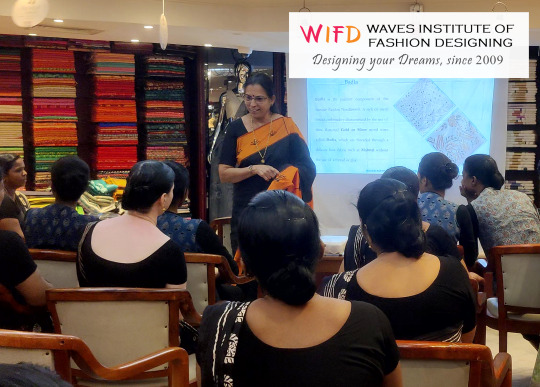


𝐄𝐥𝐞𝐯𝐚𝐭𝐢𝐧𝐠 𝐅𝐚𝐬𝐡𝐢𝐨𝐧 𝐄𝐱𝐜𝐞𝐥𝐥𝐞𝐧𝐜𝐞: 𝐖𝐚𝐯𝐞𝐬 𝐈𝐧𝐬𝐭𝐢𝐭𝐮𝐭𝐞'𝐬 𝐈𝐧𝐬𝐩𝐢𝐫𝐢𝐧𝐠 𝐓𝐫𝐚𝐢𝐧𝐢𝐧𝐠 𝐒𝐞𝐬𝐬𝐢𝐨𝐧!
𝐖𝐚𝐯𝐞𝐬 𝐈𝐧𝐬𝐭𝐢𝐭𝐮𝐭𝐞 𝐨𝐟 𝐅𝐚𝐬𝐡𝐢𝐨𝐧 𝐃𝐞𝐬𝐢𝐠𝐧𝐢𝐧𝐠 was graciously extended an invitation to facilitate an enriching Training Session on "𝐌𝐚𝐬𝐭𝐞𝐫𝐢𝐧𝐠 𝐭𝐡𝐞 𝐀𝐫𝐭 𝐨𝐟 𝐅𝐚𝐬𝐡𝐢𝐨𝐧 𝐌𝐞𝐫𝐜𝐡𝐚𝐧𝐝𝐢𝐬𝐢𝐧𝐠" at 𝐊𝐚𝐥𝐲𝐚𝐧 𝐊𝐞𝐧𝐝𝐫𝐚. On a lively Saturday (14th October), the venue buzzed with enthusiasm and a thirst for knowledge. The dedicated staff of the firm delved deep into the intricacies of Fashion Merchandising. For 𝐖𝐚𝐯𝐞𝐬 𝐈𝐧𝐬𝐭𝐢𝐭𝐮𝐭𝐞, the event was a source of immense happiness, marking a significant stride toward excellence in the fashion realm. The session’s success underscored the shared commitment to continuous learning and growth, promising a brighter future for all participants involved…
Regards,
Waves Institute of Fashion Designing
#fashion design#fashion designing#fashion education#fashion training#fashion design training#professional growth#fashion industry#empowered staff#learning journey#calicut#kozhikode#wifd
0 notes
Text
Fashion Design Trends: Exploring What's New and Next in Fashion
Fashion is a dynamic and ever-evolving industry, with trends constantly emerging, evolving, and reshaping the landscape of style. From bold prints and vibrant colors to innovative silhouettes and sustainable practices, the world of fashion is always buzzing with excitement and anticipation.
In this article, we'll take a closer look at the latest trends shaping the fashion industry and how IIFD Kolkata can help you stay ahead of the curve.
Sustainable Fashion:
With growing awareness of environmental issues and ethical concerns, sustainability has become a major focus in the fashion industry. Designers are embracing eco-friendly materials, ethical production practices, and circular design principles to minimize their environmental impact and promote a more sustainable future. At IIFD Kolkata, we're committed to educating the next generation of designers on the importance of sustainability and equipping them with the skills and knowledge needed to create fashion that's both stylish and sustainable.
Genderless Fashion:
Gender fluidity and inclusivity are driving forces in the fashion industry, with designers challenging traditional notions of masculinity and femininity and embracing a more gender-neutral approach to design. From unisex clothing lines to genderless runway shows, fashion is becoming increasingly diverse and inclusive. At IIFD Kolkata, we celebrate diversity and encourage our students to explore new forms of expression and push the boundaries of gender norms in their designs.
Digital Fashion:
As technology continues to revolutionize the way we experience fashion, digital fashion is emerging as a major trend in the industry. From virtual fashion shows and digital avatars to augmented reality try-on experiences, designers are finding innovative ways to merge the physical and digital worlds. At IIFD Kolkata, we're at the forefront of digital innovation, offering courses that teach students how to harness the power of technology to create immersive and engaging fashion experiences.
Bold Prints and Colors:
In a world that's often dominated by neutral tones and minimalist designs, bold prints and vibrant colors are making a comeback in a big way. From psychedelic patterns and geometric motifs to eye-catching hues and neon accents, designers are embracing boldness and self-expression in their collections. At IIFD Kolkata, we encourage our students to experiment with color and pattern, helping them develop their own unique visual language and signature style.
Slow Fashion:
In contrast to the fast-paced nature of the fashion industry, slow fashion is gaining momentum as a movement towards more mindful and intentional consumption. With a focus on quality over quantity, craftsmanship over mass production, and longevity over trends, slow fashion encourages a more thoughtful and sustainable approach to dressing. At IIFD Kolkata, we instill the values of craftsmanship, quality, and longevity in our students, preparing them to create fashion that stands the test of time.
Conclusion:
Fashion design trends are constantly evolving, reflecting the ever-changing tastes, values, and aspirations of society. From sustainability and inclusivity to digital innovation and self-expression, the latest trends in fashion offer endless opportunities for creativity and innovation. At IIFD Kolkata - the best fashion designing college in Kolkata, we're dedicated to staying at the forefront of these trends, providing our students with the skills, knowledge, and inspiration they need to thrive in the dynamic world of fashion. Join IIFD Kolkata and explore what's new and next in fashion today.
#Trends#fashion design#fashion designing#iifd#iifd kolkata#careers#fashion#fashion education#designing#design education#education#fashion design college#fashion design education#fashion design institute
0 notes